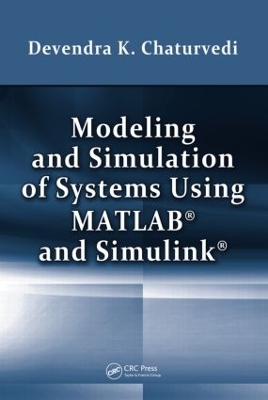
Modeling and Simulation of Systems Using MATLAB and Simulink
Seiten
2009
Crc Press Inc (Verlag)
978-1-4398-0672-2 (ISBN)
Crc Press Inc (Verlag)
978-1-4398-0672-2 (ISBN)
Provides coverage of the important aspects of modeling and simulating both physical and conceptual systems. The author presents a step-by-step procedure for modeling using top-down, bottom-up, and middle-out approaches. He develops models for complex systems and reduces their order so they can be applied effectively in online applications.
Not only do modeling and simulation help provide a better understanding of how real-world systems function, they also enable us to predict system behavior before a system is actually built and analyze systems accurately under varying operating conditions. Modeling and Simulation of Systems Using MATLAB® and Simulink® provides comprehensive, state-of-the-art coverage of all the important aspects of modeling and simulating both physical and conceptual systems. Various real-life examples show how simulation plays a key role in understanding real-world systems. The author also explains how to effectively use MATLAB and Simulink software to successfully apply the modeling and simulation techniques presented.
After introducing the underlying philosophy of systems, the book offers step-by-step procedures for modeling different types of systems using modeling techniques, such as the graph-theoretic approach, interpretive structural modeling, and system dynamics modeling. It then explores how simulation evolved from pre-computer days into the current science of today. The text also presents modern soft computing techniques, including artificial neural networks, fuzzy systems, and genetic algorithms, for modeling and simulating complex and nonlinear systems. The final chapter addresses discrete systems modeling.
Preparing both undergraduate and graduate students for advanced modeling and simulation courses, this text helps them carry out effective simulation studies. In addition, graduate students should be able to comprehend and conduct simulation research after completing this book.
Not only do modeling and simulation help provide a better understanding of how real-world systems function, they also enable us to predict system behavior before a system is actually built and analyze systems accurately under varying operating conditions. Modeling and Simulation of Systems Using MATLAB® and Simulink® provides comprehensive, state-of-the-art coverage of all the important aspects of modeling and simulating both physical and conceptual systems. Various real-life examples show how simulation plays a key role in understanding real-world systems. The author also explains how to effectively use MATLAB and Simulink software to successfully apply the modeling and simulation techniques presented.
After introducing the underlying philosophy of systems, the book offers step-by-step procedures for modeling different types of systems using modeling techniques, such as the graph-theoretic approach, interpretive structural modeling, and system dynamics modeling. It then explores how simulation evolved from pre-computer days into the current science of today. The text also presents modern soft computing techniques, including artificial neural networks, fuzzy systems, and genetic algorithms, for modeling and simulating complex and nonlinear systems. The final chapter addresses discrete systems modeling.
Preparing both undergraduate and graduate students for advanced modeling and simulation courses, this text helps them carry out effective simulation studies. In addition, graduate students should be able to comprehend and conduct simulation research after completing this book.
Devendra K. Chaturvedi is a professor in the Department of Electrical Engineering at Dayalbagh Educational Institute in India.
Introduction to Systems. Systems Modeling. Formulation of State Space Model of Systems. Model Order Reduction. Analogous of Linear Systems. Interpretive Structural Modeling. System Dynamics Techniques. Simulation. Nonlinear and Chaotic Systems. Modeling with Artificial Neural Network. Modeling Using Fuzzy Systems. Discrete-Event Modeling and Simulation. Appendices. Index.
| Erscheint lt. Verlag | 4.1.2010 |
|---|---|
| Zusatzinfo | 91 Tables, black and white; 603 Illustrations, black and white |
| Verlagsort | Bosa Roca |
| Sprache | englisch |
| Maße | 178 x 254 mm |
| Gewicht | 1474 g |
| Themenwelt | Mathematik / Informatik ► Informatik ► Theorie / Studium |
| Mathematik / Informatik ► Mathematik ► Computerprogramme / Computeralgebra | |
| Technik ► Elektrotechnik / Energietechnik | |
| Technik ► Umwelttechnik / Biotechnologie | |
| ISBN-10 | 1-4398-0672-1 / 1439806721 |
| ISBN-13 | 978-1-4398-0672-2 / 9781439806722 |
| Zustand | Neuware |
| Informationen gemäß Produktsicherheitsverordnung (GPSR) | |
| Haben Sie eine Frage zum Produkt? |
Mehr entdecken
aus dem Bereich
aus dem Bereich
eine praxisorientierte Einführung
Buch | Softcover (2025)
Springer Fachmedien Wiesbaden (Verlag)
CHF 55,95
Eine Einführung in die Systemtheorie
Buch | Softcover (2022)
UTB (Verlag)
CHF 34,95
was jeder über Informatik wissen sollte
Buch (2024)
Springer Vieweg (Verlag)
CHF 53,15


